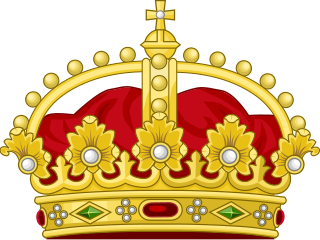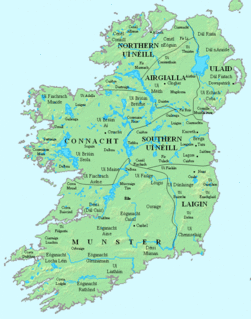Cathrannach mac Cathal, possible King of Máenmaige, died 801.

King, or king regnant is the title given to a male monarch in a variety of contexts. The female equivalent is queen regnant, while the title of queen on its own usually refers to the consort of a king.
Máenmaige was originally a kingdom, later termed a trícha cét, and in Anglo-Norman times a cantred, which formed the barony of Loughrea.
In 801 the Annals of Ulster records the deaths of Cathrannach mac Cathal of Maenmag, and the anchorite Ninnid. Nothing further appears to be known of Cathrannach. His death occurred at a time of conflict between the kingdoms of Aidhne and Uí Maine for control of Maenmaige, with Uí Maine eventually incorporating the kingdom into theirs.

The Annals of Ulster are annals of medieval Ireland. The entries span the years from A.D. 431 to A.D. 1540. The entries up to A.D. 1489 were compiled in the late 15th century by the scribe Ruaidhrí Ó Luinín, under his patron Cathal Óg Mac Maghnusa on the island of Belle Isle on Lough Erne in the kingdom of Fermanagh. Later entries were added by others.

Aidhne, also known as Uí Fhiachrach Aidhne, Maigh Aidhne / Maigh nAidhne, was the territory of the Uí Fiachrach Aidhne, a tuath located in the south of what is now County Galway in the south of Connacht, Ireland. Aidhne is coextensive with the present diocese of Kilmacduagh. The territory of Aidhne is bounded on the west by Loch Lurgain and the barony of Burren in County Clare in the province of Munster. County Clare also bounds Aidhne on its south and south-east side. Aidhne is bounded on the east by the low mountains of Sliabh Echtghe / Slieve Aughty, which separate Uí Fhiachrach Aidhne from the territory of Uí Mhaine in eastern County Galway. On the north-east Aidhne is bounded by the plains of Uí Mhaine and on the north by Maigh Mucruimhe. On the north-west Aidhne is bounded by the parish of Meadhraighe / Maree (Ballynacourty) which is in the territory of Uí Bhriúin Seola.

Uí Maine, often Anglicised as Hy Many, was one of the oldest and largest kingdoms located in Connacht, Ireland. Its territory of approximately 1,000 square miles (2,600 km2) encompassed all of what is now north, east and south County Galway, south and central County Roscommon, an area near County Clare, and at one stage had apparently subjugated land on the east bank of the Shannon, together with the parish of Lusmagh in Offaly.

